Mahmoud AlaaEldin
Performance Characterization of Continuous Reconfigurable Intelligent Surfaces
Jun 17, 2025Abstract:We consider a reconfigurable intelligent surface (RIS) that can implement a phase rotation continuously over the whole surface rather than via a finite number of discrete elements. Such an RIS can be considered a design for future systems where advances in metamaterials make such an implementation feasible or as the limiting case where the number of elements in a traditional RIS increases in a given area. We derive the optimal RIS design for the single-user (SU) scenario assuming a line-of-sight (LoS) from the RIS to the base station (BS) and correlated Rayleigh fading for the other links. We also derive the associated optimal signal-to-noise ratio (SNR) and its mean, a bound on the mean spectral efficiency (SE), an approximation to the SNR outage probability and an approximation to the coefficient of variation for the investigation of channel hardening.
RIS-enabled Multi-user M-QAM Uplink NOMA Systems: Design, Analysis, and Optimization
Mar 05, 2025Abstract:Non-orthogonal multiple access (NOMA) is widely recognized for enhancing the energy and spectral efficiency through effective radio resource sharing. However, uplink NOMA systems face greater challenges than their downlink counterparts, as their bit error rate (BER) performance is hindered by an inherent error floor due to error propagation caused by imperfect successive interference cancellation (SIC). This paper investigates BER performance improvements enabled by reconfigurable intelligent surfaces (RISs) in multi-user uplink NOMA transmission. Specifically, we propose a novel RIS-assisted uplink NOMA design, where the RIS phase shifts are optimized to enhance the received signal amplitudes while mitigating the phase rotations induced by the channel. To achieve this, we first develop an accurate channel model for the effective user channels, which facilitates our BER analysis. We then introduce a channel alignment scheme for a two-user scenario, enabling efficient SIC-based detection and deriving closed-form BER expressions. We further extend the analysis to a generalized setup with an arbitrary number of users and modulation orders for quadrature amplitude modulation signaling. Using the derived BER expressions, we develop an optimized uplink NOMA power allocation (PA) scheme that minimizes the average BER while satisfying the user transmit power constraints. It will be shown that the proposed NOMA detection scheme, in conjunction with the optimized PA strategy, eliminate SIC error floors at the base station. The theoretical BER expressions are validated using simulations, which confirms the effectiveness of the proposed design in eliminating BER floors.
On the Performance of Pilot-Aided Simultaneous Communication and Tracking
Oct 09, 2024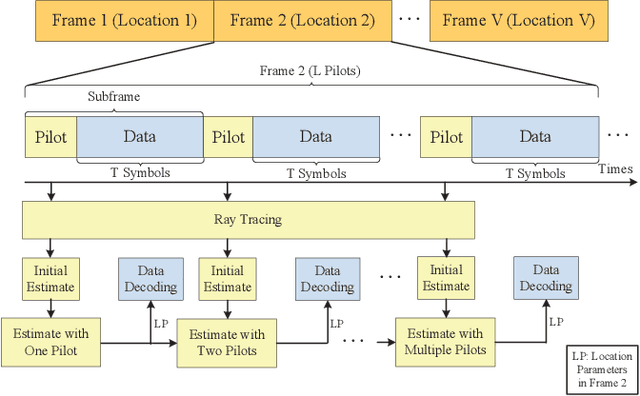
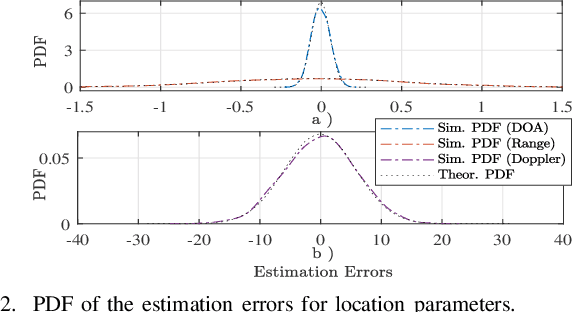
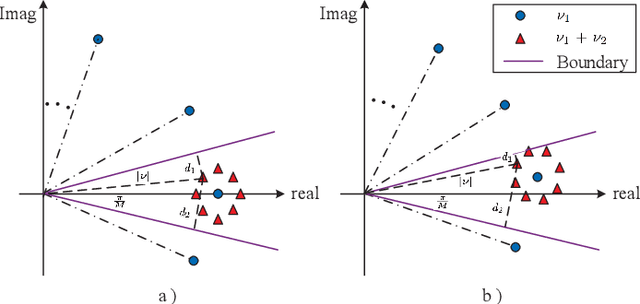
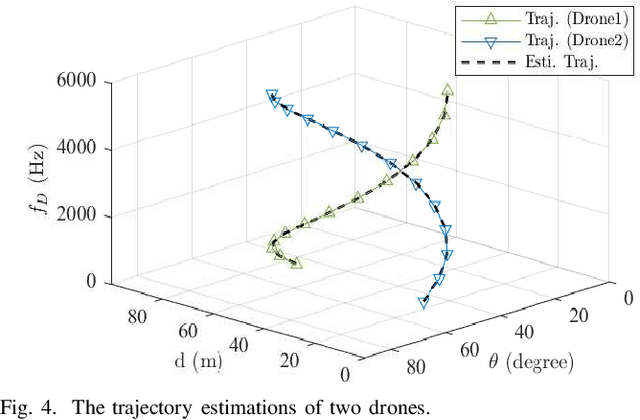
Abstract:In this paper, the symbol error rate performance analysis is provided for a pilot-aided simultaneous communication and tracking (PASCAT) system. In specific, we employ multiple drones to actively transmit signals to a BS, which is responsible for continuously monitoring the location of drones over time and decoding the symbols transmitted from the drones. It is found that the estimated location parameters at a given moment during tracking follow Gaussian distributions with means equal to actual values and variances equal to root mean square error (RMSE). Afterwards, the obtained location information is employed for informing the channel information, which is then used to preprocess the received signal before decoding by using the maximum ratio combining (MRC) technique. The average symbol error rate (SER) is also evaluated over the distribution of the estimated location parameters and an approximate value for the average SER is obtained by using a Taylor approximation with fast convergence. The result indicates that there is a cooperation relationship between the RMSE of the estimated location parameters and the average SER. In addition, the effect of the number of pilot signals is analysed as well. By employing more pilots, it is found that both communication and sensing functionalities are enhanced. Furthermore, the SER performance of our PASCAT system is similar to that of maximum likelihood detection (MLD) when a number of pilot signals are employed, which demonstrates the efficiency of the PASCAT system. In the end, all results are validated by using Monte Carlo simulations.
Generalized BER Performance Analysis for SIC-based Uplink NOMA Systems
May 30, 2024



Abstract:Non-orthogonal multiple access (NOMA) is widely recognized for its spectral and energy efficiency, which allows more users to share the network resources more effectively. This paper provides a generalized bit error rate (BER) performance analysis of successive interference cancellation (SIC)-based uplink NOMA systems under Rayleigh fading channels, taking into account error propagation resulting from SIC imperfections. Exact closed-form BER expressions are initially derived for scenarios with 2 and 3 users using quadrature phase shift keying (QPSK) modulation. These expressions are then generalized to encompass any arbitrary rectangular/square M-ary quadrature amplitude modulation (M-QAM) order, number of NOMA users, and number of BS antennas. Additionally, by utilizing the derived closed-form BER expressions, a simple and practically feasible power allocation (PA) technique is devised to minimize the sum bit error rate of the users and optimize the SIC-based NOMA detection at the base-station (BS). The derived closed-form expressions are corroborated through Monte Carlo simulations. It is demonstrated that these expressions can be effective for optimal uplink PA to ensure optimized SIC detection that mitigates error floors. It is also shown that significant performance improvements are achieved regardless of the users' decoding order, making uplink SIC-based NOMA a viable approach.
Robust Joint Active-Passive Beamforming Design for IRS-Assisted ISAC Systems
Sep 02, 2023Abstract:The idea of Integrated Sensing and Communication (ISAC) offers a promising solution to the problem of spectrum congestion in future wireless networks. This paper studies the integration of intelligent reflective surfaces (IRS) with ISAC systems to improve the performance of radar and communication services. Specifically, an IRS-assisted ISAC system is investigated where a multi-antenna base station (BS) performs multi-target detection and multi-user communication. A low complexity and efficient joint optimization of transmit beamforming at the BS and reflective beamforming at the IRS is proposed. This is done by jointly optimizing the BS beamformers and IRS reflection coefficients to minimize the Frobenius distance between the covariance matrices of the transmitted signal and the desired radar beam pattern. This optimization aims to satisfy the signal-to-interference-and-noise ratio (SINR) constraints of the communication users, the total transmit power limit at the BS, and the unit modulus constraints of the IRS reflection coefficients. To address the resulting complex non-convex optimization problem, an efficient alternating optimization (AO) algorithm combining fractional programming (FP), semi-definite programming (SDP), and second order cone programming (SOCP) methods is proposed. Furthermore, we propose robust beamforming optimization for IRS-ISAC systems by adapting the proposed optimization algorithm to the IRS channel uncertainties that may exist in practical systems. Using advanced tools from convex optimization theory, the constraints containing uncertainty are transformed to their equivalent linear matrix inequalities (LMIs) to account for the channels' uncertainty radius. The results presented quantify the benefits of IRS-ISAC systems under various conditions and demonstrate the effectiveness of the proposed algorithm.
Optimization of Energy-Constrained IRS-NOMA Using a Complex Circle Manifold Approach
Jun 02, 2022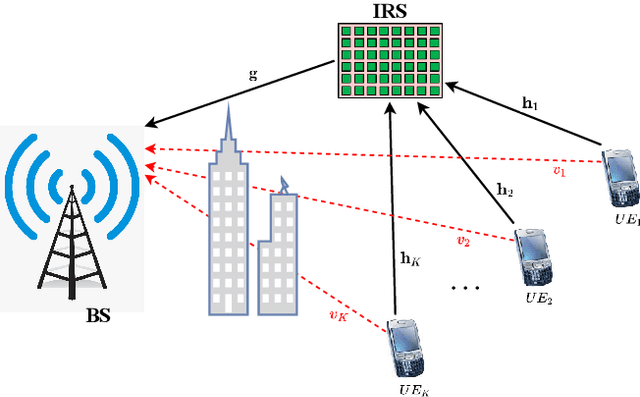


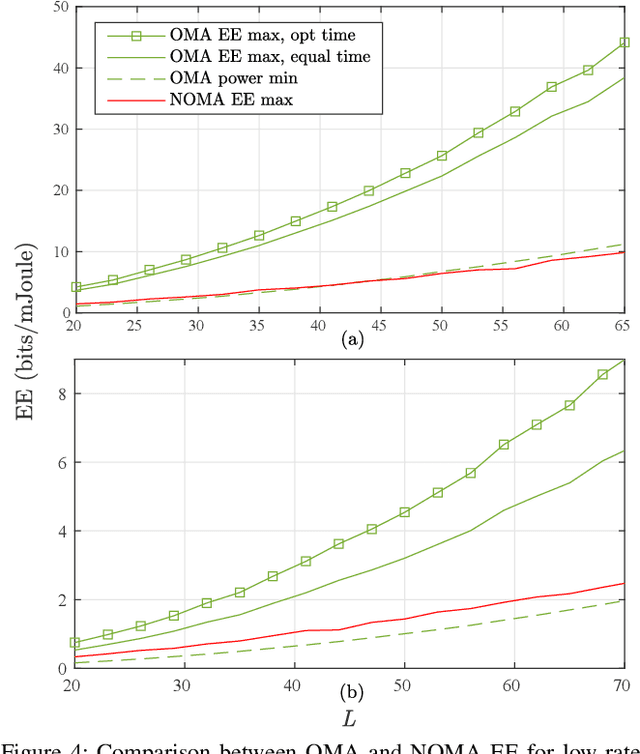
Abstract:This work investigates the performance of intelligent reflective surfaces (IRSs) assisted uplink non-orthogonal multiple access (NOMA) in energy-constrained networks. Specifically, we formulate and solve two optimization problems, one for minimizing the users' sum transmit power and another for maximizing the energy efficiency (EE) of the system. The two problems are solved by jointly optimizing the users' transmit powers and the passive beamforming coefficients at the IRS reflectors subject to the users' individual uplink rate constraints. A novel algorithm is developed to optimize the IRS passive beamforming coefficients by optimizing the objective function over the \textit{complex circle manifold} (CCM), exploiting the manifold optimization technique. The proposed manifold optimization-based solution is bench-marked against the rather \textit{standard} semi-definite relaxation method (SDR). The results show that the manifold optimization-based algorithm achieves significantly better performance for both transmit power minimization and EE maximization problems at a computational complexity lower than the SDR approach. The results also reveal that IRS-NOMA is superior to the orthogonal multiple access (OMA) counterpart only when the users' target achievable rate requirements are relatively high.
 Add to Chrome
Add to Chrome Add to Firefox
Add to Firefox Add to Edge
Add to Edge